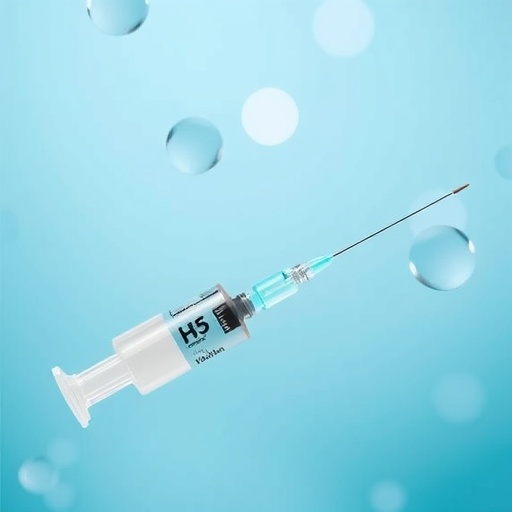In the perpetual battle against influenza viruses, a new hope emerges from cutting-edge vaccine research that promises broader protection, particularly against the notoriously dangerous H5N1 avian influenza virus. A groundbreaking phase I clinical trial has revealed that an intranasal adjuvanted, recombinant influenza A/H5 vaccine can prime the immune system effectively against diverse clades of H5N1. This discovery could pave the way for a universal influenza vaccine strategy, a holy grail in infectious disease prevention.
The study, led by Deming, Toapanta, and Pasetti, marks a significant breakthrough by utilizing a recombinant technology combined with an innovative delivery method. Unlike conventional vaccines administered intramuscularly, this novel candidate is delivered intranasally. This approach is designed to stimulate mucosal immunity directly in the respiratory tract — the primary site of influenza virus entry and replication. By harnessing local immune defense mechanisms, the vaccine may offer superior protection and reduce transmission rates.
Recombinant vaccine technology involves the production of viral antigens using engineered genetic materials in a laboratory setting. This method allows for precise targeting of the hemagglutinin (HA) protein, a critical surface antigen of the influenza virus responsible for host cell attachment. The vaccine in question features a recombinant form of the HA protein from the H5 subtype, expertly engineered to provoke a robust immune response without introducing live virus, thus enhancing safety.
Central to the vaccine’s efficacy is the inclusion of an adjuvant— a compound that boosts the immune system’s response to the antigen. The adjuvant used in this study augments the activation of antigen-presenting cells and promotes the generation of long-lasting memory B and T cells. This ensures that the immune system not only responds vigorously after vaccination but also retains the ability to recognize and combat a wide array of H5N1 viral strains in the future.
The challenge posed by H5N1 lies in its genetic diversity, with multiple clades exhibiting different antigenic profiles. Traditional vaccines often fail to provide cross-protection across these variants. However, the phase I trial results demonstrated that this recombinant vaccine induced immunity capable of priming the immune system broadly, showcasing responses against multiple divergent clades. This cross-clade reactivity is crucial for preempting potential pandemics originating from novel H5N1 strains.
Safety and tolerability are vital milestones in vaccine development, especially with novel formulations and delivery routes. The intranasal vaccine was well-tolerated by trial participants, with no severe adverse events linked to its administration. Mild local symptoms, such as nasal irritation, were transient and resolved without intervention. This safety profile supports further clinical development and underscores the feasibility of intranasal vaccines in humans.
Immunogenicity—the ability of a vaccine to provoke an immune response—was assessed by measuring neutralizing antibody titers and T-cell responses. Participants exhibited significant increases in neutralizing antibodies against diverse H5N1 strains, indicating a strong humoral immune response. Additionally, enhanced T-cell activation was observed, reflecting a comprehensive cellular immune defense. Such dual-arm immunity is critical for both immediate viral neutralization and long-term protection.
The intranasal route offers logistical advantages over intramuscular injections. It facilitates needle-free administration, which can increase vaccine acceptance and coverage, particularly in resource-limited regions and among needle-phobic populations. Furthermore, mucosal immunity has the potential to inhibit viral replication and shedding at the point of entry, thereby decreasing potential transmission—a crucial factor in controlling outbreaks.
Technologically, this vaccine represents the convergence of advanced molecular biology, immunology, and pharmaceutical sciences. Recombinant DNA technology, adjuvant science, and nasal delivery devices have been fine-tuned to orchestrate an optimal immune response. This integration could redefine influenza vaccination paradigms and inspire similar strategies for other respiratory viruses such as SARS-CoV-2 and respiratory syncytial virus.
While the study was limited to phase I—primarily evaluating safety and immunogenicity—its promising results justify progression to larger trials. Subsequent phases will assess efficacy in diverse populations, dosing schedules, and long-term protection. Moreover, understanding the vaccine’s ability to reduce transmission and severe disease in real-world settings will be paramount for its global implementation.
This vaccine’s development arrives at a critical juncture. Influenza remains a persistent threat with seasonal epidemics and pandemic potential always looming. H5N1, in particular, has caused sporadic human infections with high mortality rates. Current vaccine production methods are slow and strain-specific, often lagging behind viral evolution. A fast-acting, broadly protective intranasal vaccine could revolutionize public health responses to influenza outbreaks.
The broader implications of this research extend beyond influenza. Intranasal delivery and recombinant antigen platforms can be adapted rapidly to emerging pathogens, offering a more nimble response to novel infectious threats. The observed cross-clade immunity opens the possibility of universal vaccines that cover multiple variants, reducing the need for annual reformulation and mass vaccination campaigns.
Efforts to scale manufacturing and distribution will be crucial for future success. The vaccine’s recombinant nature facilitates rapid and scalable production in cell cultures, bypassing egg-based containment systems that can delay availability. Coupled with the simplicity of nasal administration, this approach may lower barriers to widespread immunization, especially in low- and middle-income countries where influenza burden is significant.
In summary, the intranasal adjuvanted recombinant H5 vaccine trial represents a pioneering step toward universal influenza vaccination. By effectively priming immunity against diverse clades of H5N1, it addresses key challenges in viral variability and vaccine delivery. If confirmed in later-stage studies, this innovation holds the promise of transforming influenza prevention worldwide and enhancing preparedness for future pandemics.
As this novel vaccine advances through clinical development, the scientific community eagerly anticipates its impact on global influenza control strategies. The integration of advanced biotechnology and mucosal immunology could redefine effective vaccination, protecting millions from seasonal epidemics and pandemic threats. This research underscores the vital role of innovative science in safeguarding public health in an ever-changing viral landscape.
The journey from bench to bedside for this vaccine illustrates the power of interdisciplinary collaboration and cutting-edge technologies. Continued investment in such research is essential to stay ahead in the arms race against evolving infectious diseases. With each milestone, the possibility of a universal, easily administered influenza vaccine becomes more tangible, heralding a new era in disease prevention.
Subject of Research: Development and clinical evaluation of an intranasal adjuvanted recombinant influenza A/H5 vaccine conferring cross-clade immunity against diverse H5N1 strains.
Article Title: An intranasal adjuvanted, recombinant influenza A/H5 vaccine primes against diverse H5N1 clades: a phase I trial.
Article References:
Deming, M.E., Toapanta, F.R., Pasetti, M. et al. An intranasal adjuvanted, recombinant influenza A/H5 vaccine primes against diverse H5N1 clades: a phase I trial. Nat Commun 16, 9321 (2025). https://doi.org/10.1038/s41467-025-64686-3
Image Credits: AI Generated
DOI: https://doi.org/10.1038/s41467-025-64686-3
Tags: H5N1 avian influenza protectionhemagglutinin protein targetingimmune system priming against influenzainfectious disease prevention advancementsinnovative vaccine delivery methodsintranasal influenza vaccinemucosal immunity stimulationphase I clinical trial findingsrecombinant vaccine technologyrespiratory tract immunityuniversal influenza vaccine strategyviral antigens production techniques





